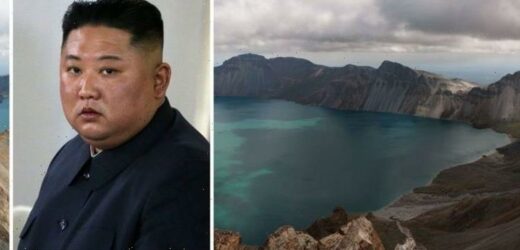North Korea stages children's show about coronavirus rules
We use your sign-up to provide content in ways you’ve consented to and to improve our understanding of you. This may include adverts from us and 3rd parties based on our understanding. You can unsubscribe at any time. More info
Kim Jong-un and North Korea continue to conduct hypersonic missile tests. Earlier this week, the country’s state media confirmed a missile had successfully made a turn before hitting its target in the sea some 1,000km (621 miles) away. It is North Korea’s third reported test of a hypersonic missile, which travels at five times the speed of sound (3,850mph) and avoids detection for longer than ballistic missiles. The North Korean leader vowed to ramp up his country’s defence capabilities in his New Year goals.
Six countries — including the United States — issued a joint statement condemning an apparent test at the beginning of the month.
The first reported hypersonic missile test took place in September last year.
Ten years earlier, in 2011, North Korea enlisted the help of Western scientists amid concerns over Mount Paektu, an active stratovolcano on the Chinese-North Korean border.
The rare collaboration revealed the fiery soul of the region’s sleeping beast is still rumbling.
James Hammond, a seismologist at Birkbeck, University of London, was one of the researchers sent to North Korea.


They set up six seismometers up to 60km to the east of the volcano’s rim in North Korea, as well as two much closer to the volcano on the Chinese side.
Mr Hammond said: “If you put up a station in North Korea under the volcano, we can look at the structure within the crust and that gives us a glimpse of the inside of the volcano.”
Analysis confirmed the presence of a “mushy zone” of partially melted magma, measuring at least 20km across and “penetrating from the surface, or near the surface, down all the way through the crust”.
Although there have been very minor eruptions in 1668, 1702 and 1903, Paektu is capable of much, much more.
The 946 AD eruption, known as the ‘Millennium eruption’, was the second largest ever recorded — topped only by the Mount Tambora eruption in Indonesia in 1815, which caused the ‘Year Without a Summer’.

Paektu’s eruption was 1,000 times more powerful than Mount St Helens in 1980, the largest eruption in living memory, and plunged the area into darkness as 45 million tonnes of sulphur droplets flooded the skies.
A 2016 study published in Scientific Reports suggests North Korea’s underground weapons tests are sending sizable pressure waves towards the magma chamber.
Should the volcano be primed to erupt, which it does not appear to be at the moment, additional pressure waves could ultimately be the trigger point.
Seismic activity was detected at the volcano at the turn of the millennium, but this seems to have largely tailed off now.
Though current missile tests are not underground weapons, previous tests have been.
DON’T MISS:
Archaeologists stunned as ‘oldest evidence of mankind’ found in Africa [NEW]
Archaeology: Shipwreck found in British waters 105 years after it sank [INSIGHT]
Archaeology breakthrough: Rare armour found in ancient China [REPORT]

The study describes underground nuclear explosion tests as a “direct threat to the volcano”.
It continued: “North Korean underground nuclear explosions with magnitudes of 5.0-7.6 may induce overpressure in the magma chamber of several tens to hundreds of kilopascals.”
The study said previous explosions had magnitudes of 4.3, 4.7 and 5.1, with more recent ones reaching 5.5-5.6.
These had explosive yields of around 10 kilotons of TNT. The atomic bomb dropped on Nagasaki at the end of World War 2 had an explosive yield of around twice that.
Previous underground nuclear explosion tests have, however, shown that detonation strength can surpass a magnitude of 7.0.

The study warned: “Large UNEs may produce strong seismic waves over local and regional distances.
“Dynamic stress changes induced by transient seismic waves can over pressurise the magma and trigger volcanic eruption.”
It should be noted, however, that an eruption would only likely be triggered if it were already on the verge of erupting anyway.
Tracy Gregg, a planetary volcanologist, told Vice in 2017: “It’s possible that if the volcano were already on the verge of erupting anyway, an extra seismic ‘kick’ from a bomb might push the volcano over the edge and cause it to erupt a bit earlier than it was planning to anyway.”
But, she added: “There’s no indication that Mount Paektu is primed.”
Likewise, there remains little clarity over the type of eruption it could be. It is highly possible that a new eruption at Paektu would be more like the recent, more moderate ones.
Volcanologists remain unsure whether underground nuclear testing affects magma chambers, if at all.
Forbes reported in 2017 that several powerful underground nuclear tests in the Aleutian Arc, a volcanic region, during the Cold War seemed to have zero impact.
Source: Read Full Article


